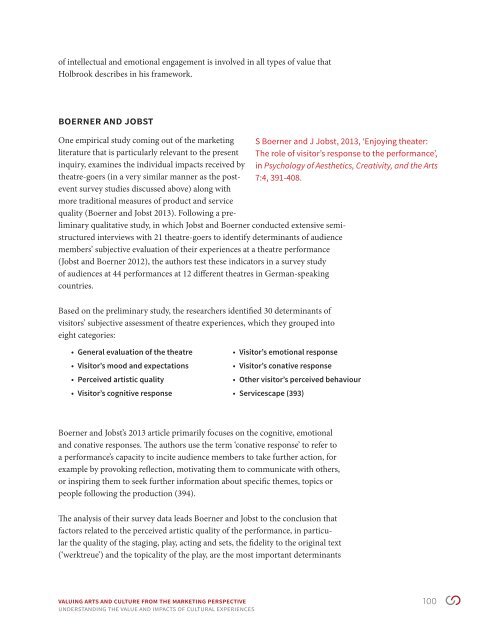aceUVi
aceUVi
aceUVi
Create successful ePaper yourself
Turn your PDF publications into a flip-book with our unique Google optimized e-Paper software.
of intellectual and emotional engagement is involved in all types of value that<br />
Holbrook describes in his framework.<br />
Boerner and Jobst<br />
One empirical study coming out of the marketing<br />
literature that is particularly relevant to the present<br />
inquiry, examines the individual impacts received by<br />
theatre-goers (in a very similar manner as the postevent<br />
survey studies discussed above) along with<br />
more traditional measures of product and service<br />
quality (Boerner and Jobst 2013). Following a preliminary<br />
qualitative study, in which Jobst and Boerner conducted extensive semistructured<br />
interviews with 21 theatre-goers to identify determinants of audience<br />
members’ subjective evaluation of their experiences at a theatre performance<br />
(Jobst and Boerner 2012), the authors test these indicators in a survey study<br />
of audiences at 44 performances at 12 different theatres in German-speaking<br />
countries.<br />
Based on the preliminary study, the researchers identified 30 determinants of<br />
visitors’ subjective assessment of theatre experiences, which they grouped into<br />
eight categories:<br />
S Boerner and J Jobst, 2013, ‘Enjoying theater:<br />
The role of visitor’s response to the performance’,<br />
in Psychology of Aesthetics, Creativity, and the Arts<br />
7:4, 391-408.<br />
• General evaluation of the theatre<br />
• Visitor’s mood and expectations<br />
• Perceived artistic quality<br />
• Visitor’s cognitive response<br />
• Visitor’s emotional response<br />
• Visitor’s conative response<br />
• Other visitor’s perceived behaviour<br />
• Servicescape (393)<br />
Boerner and Jobst’s 2013 article primarily focuses on the cognitive, emotional<br />
and conative responses. The authors use the term ‘conative response’ to refer to<br />
a performance’s capacity to incite audience members to take further action, for<br />
example by provoking reflection, motivating them to communicate with others,<br />
or inspiring them to seek further information about specific themes, topics or<br />
people following the production (394).<br />
The analysis of their survey data leads Boerner and Jobst to the conclusion that<br />
factors related to the perceived artistic quality of the performance, in particular<br />
the quality of the staging, play, acting and sets, the fidelity to the original text<br />
(‘werktreue’) and the topicality of the play, are the most important determinants<br />
VALUING ARTS AND CULTURE FROM THE MARKETING PERSPECTIVE 100<br />
UNDERSTANDING the value and impacts of cultural experiences


